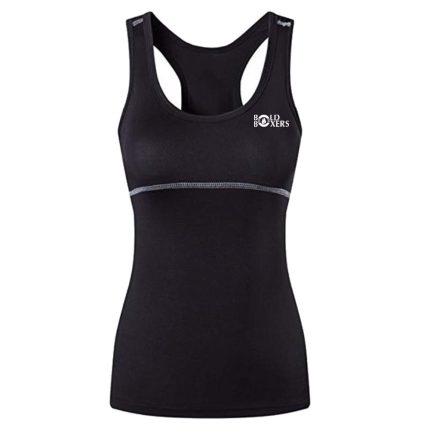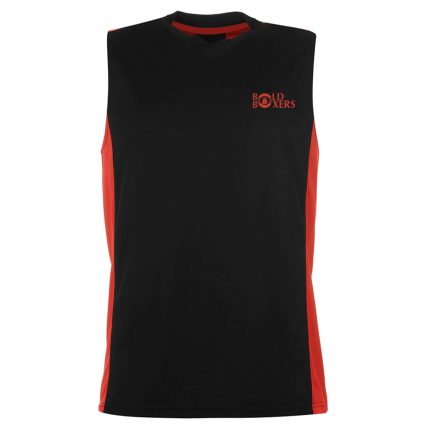Tank Tops
- Tank tops are sleeveless shirts characterized by their shoulder straps and typically low-cut neckline, providing freedom of movement and breathability during warm weather or workouts.
- They come in various styles, including racerback, scoop neck, and muscle tanks, catering to different preferences and activities.
- Tank tops are made from lightweight and breathable fabrics such as cotton, polyester, or blends, ensuring comfort and moisture-wicking properties.
- Popular for casual wear, sports, and gym workouts, tank tops offer versatility for various occasions and activities.
- They can be worn alone or layered under jackets or sweaters for added style and warmth during cooler weather.
- Available in a wide range of colors, patterns, and designs, from basic solid colors to bold prints and graphic designs, allowing for personal expression and style customization.
Tank Tops
- Tank tops are sleeveless shirts characterized by their shoulder straps and typically low-cut neckline, providing freedom of movement and breathability during warm weather or workouts.
- They come in various styles, including racerback, scoop neck, and muscle tanks, catering to different preferences and activities.
- Tank tops are made from lightweight and breathable fabrics such as cotton, polyester, or blends, ensuring comfort and moisture-wicking properties.
- Popular for casual wear, sports, and gym workouts, tank tops offer versatility for various occasions and activities.
- They can be worn alone or layered under jackets or sweaters for added style and warmth during cooler weather.
- Available in a wide range of colors, patterns, and designs, from basic solid colors to bold prints and graphic designs, allowing for personal expression and style customization.
Tank Tops
- Tank tops are sleeveless shirts characterized by their shoulder straps and typically low-cut neckline, providing freedom of movement and breathability during warm weather or workouts.
- They come in various styles, including racerback, scoop neck, and muscle tanks, catering to different preferences and activities.
- Tank tops are made from lightweight and breathable fabrics such as cotton, polyester, or blends, ensuring comfort and moisture-wicking properties.
- Popular for casual wear, sports, and gym workouts, tank tops offer versatility for various occasions and activities.
- They can be worn alone or layered under jackets or sweaters for added style and warmth during cooler weather.
- Available in a wide range of colors, patterns, and designs, from basic solid colors to bold prints and graphic designs, allowing for personal expression and style customization.
Tank Tops
- Tank tops are sleeveless shirts characterized by their shoulder straps and typically low-cut neckline, providing freedom of movement and breathability during warm weather or workouts.
- They come in various styles, including racerback, scoop neck, and muscle tanks, catering to different preferences and activities.
- Tank tops are made from lightweight and breathable fabrics such as cotton, polyester, or blends, ensuring comfort and moisture-wicking properties.
- Popular for casual wear, sports, and gym workouts, tank tops offer versatility for various occasions and activities.
- They can be worn alone or layered under jackets or sweaters for added style and warmth during cooler weather.
- Available in a wide range of colors, patterns, and designs, from basic solid colors to bold prints and graphic designs, allowing for personal expression and style customization.
Tank Tops
- Tank tops are sleeveless shirts characterized by their shoulder straps and typically low-cut neckline, providing freedom of movement and breathability during warm weather or workouts.
- They come in various styles, including racerback, scoop neck, and muscle tanks, catering to different preferences and activities.
- Tank tops are made from lightweight and breathable fabrics such as cotton, polyester, or blends, ensuring comfort and moisture-wicking properties.
- Popular for casual wear, sports, and gym workouts, tank tops offer versatility for various occasions and activities.
- They can be worn alone or layered under jackets or sweaters for added style and warmth during cooler weather.
- Available in a wide range of colors, patterns, and designs, from basic solid colors to bold prints and graphic designs, allowing for personal expression and style customization.
Tank Tops
- Tank tops are sleeveless shirts characterized by their shoulder straps and typically low-cut neckline, providing freedom of movement and breathability during warm weather or workouts.
- They come in various styles, including racerback, scoop neck, and muscle tanks, catering to different preferences and activities.
- Tank tops are made from lightweight and breathable fabrics such as cotton, polyester, or blends, ensuring comfort and moisture-wicking properties.
- Popular for casual wear, sports, and gym workouts, tank tops offer versatility for various occasions and activities.
- They can be worn alone or layered under jackets or sweaters for added style and warmth during cooler weather.
- Available in a wide range of colors, patterns, and designs, from basic solid colors to bold prints and graphic designs, allowing for personal expression and style customization.













